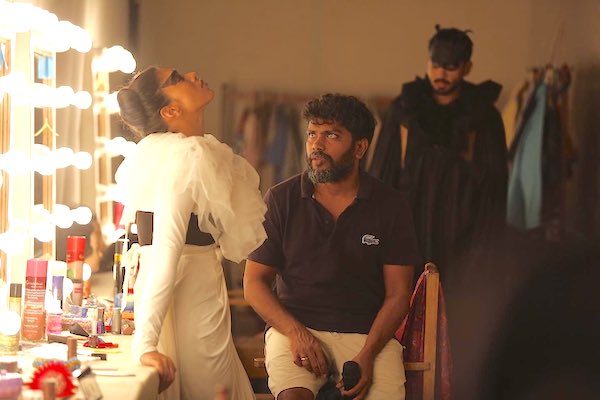Pa Ranjith’s Tamil Film ‘Natchathiram Nagargiradhu’ is a Meditation on Love, Gender, Caste and Oppression
- While casteism is always seen through men in cinema, this romantic musical shows how emotion is weaponized by oppressor caste women to uphold caste in the family.

Tamil film “Natchathiram Nagargiradhu” (The Star is Moving ) shows a theatre troupe grappling with the constructs society builds around love. Love is mediated by caste, sexuality, gender and religion. It’s political. The protagonist, Rene, (played by Dushara Vijayan) realizes that she cannot escape casteism even in discussions about something like music choices. She lives independently, and her books and fashion choices indicate economic stability. It is a stark reminder that economic progress cannot solve all the problems of Dalits. Her birth name, Tamizh (now people call it Tamil), symbolizes that speaking the same language is not enough to unite us if we still believe in caste hierarchies.
The film’s queer and trans characters are three-dimensional, a refreshing break from mainstream caricatures. Their love and struggle for identity is shown like any other. Diana, a queer character, naively gets angry at the mention of Brahminism as the root cause of problems. He constantly faces the threat of oppression for his sexual orientation. But that doesn’t seem to remove the privilege of caste.

This movie tells of hope and redemption. Rene opens a door, illuminating the frame with light. A mural of the Buddha above the door shows us that she is an Ambedkarite who wants to show the path of the Buddha to people.
We continue to see different archetypes of oppressor caste people. The liberal views of Iniyan (Kalidas Jayaram) make his casteism subtle and sophisticated but never remove it. He subconsciously feels that just because he kissed Rene hundreds of times it’s not wrong to kiss her after their breakup. This is a layered character who identifies as progressive or liberal but isn’t.
Raw, unfiltered Arjun (Kalaiyarasan Harikrishnan) has imbibed many problematic things from his family. His transformation starts with Rene as the catalyst. Alas, Arjun cannot face his parents assertively. This indicates his change was temporary.
This character’s future is uncertain, but he has a different perspective to choose from. Many will definitely connect to this character.
Casteism is always seen through men in cinema. “Natchathiram” shows how emotion is weaponized by oppressor caste women to uphold caste in a family. We see this when Arjun reveals to his mom about loving a Scheduled Caste girl (Rene). His sister alone sees love without the construct of caste. But a lone anti-caste voice finds it difficult to be heard in a family full of casteist people. Arjun’s mom uses every emotional strategy to influence him. Even her daughter is not spared from misogynistic slurs to defend caste rules, much less Rene.
Arjun’s fiance agrees to the marriage despite his misogyny. Rene on the other hand controls her friendship with Arjun (with her own terms and conditions). This is the reason why Rene needs to be strong, independent and idealistic. Her food, her father’s profession (he plays drum), her scholarships and even her existence was inferior in the eyes of the oppressor caste people. She knows society will exploit any weakness she shows.
Theatre scenes depicting cruel caste killings are brilliant, both artistically and politically. The term ‘cat’ is used metaphorically for caste — domestic cat, wild cat, and the master cat. The master cat symbolizes people who are in a powerful position (or are in contact with powerful people) and who created oppressive social systems. It is hard to fight them, but not impossible if all who agree with the philosophy of this movie come together. White color usually symbolizes purity and goodness. Pa Ranjith turns it on its head through the villain, clad in white in his pristine white lair.
Shooting stars are a recurrent motif. This is a reference to Rohit Vemula’s suicide note where he wrote, “I loved Science, Stars, Nature, but then I loved people without knowing that people have long since divorced from nature. Our feelings are second-handed. Our love is constructed. Our beliefs are colored. Our originality is valid through artificial art. It has become truly difficult to love without getting hurt….. I don’t believe in after-death stories, ghosts, or spirits. If there is anything at all I believe, I believe that I can travel to the stars & know about the other worlds.”
The universe is something that doesn’t change, it remains as it is. It is easier for Rohit Vemula (and even Rene) to build a relationship with the stars than a fellow human being.
This movie tells of hope and redemption. Rene opens a door, illuminating the frame with light. A mural of the Buddha above the door shows us that she is an Ambedkarite who wants to show the path of the Buddha to people. “Natchathiram” is a prime example of how great films can initiate important discussions.
Lokesh Bag is a passionate writer, a movie critic, a relentless reader and a sketch artist. He has a graduate degree in Agricultural Entomology. He is an Ambedkarite and has been creating meaningful conversations about caste, gender, and social issues. He has previously been published in The Quint and he often writes on various topics in tweet-chunks on Twitter for his fans. He believes in working towards a better tomorrow, one word at a time. Follow him on Twitter.



Hi, great review. I too loved the story. I noticed a few parallels in the story of Rene and Iniyan with the characters in Minsara Kanavu (1997). Here’s my video analysis: https://youtu.be/FeHXfi-ypZw